In comes I...the Plough Monday plays of Nottinghamshire
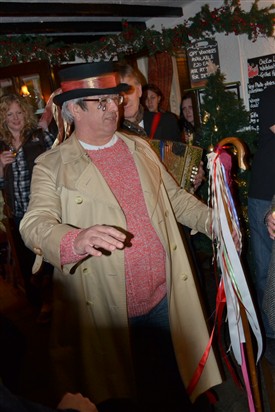
The Ribboner Calverton Plough Play CRAPPPS
RBParish
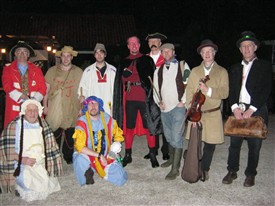
The CRAPPPS team 2012
RBParish
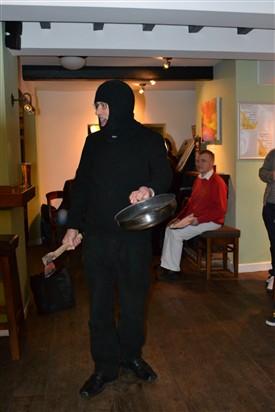
In comes Beelzebub Dolphin Morris Gotham 2013
RBParish
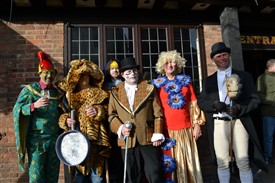
Muskham Pinkies team 2013
RBParish
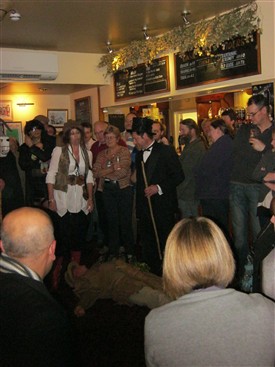
A packed pub for the Tollerton Plough Play 2012
RBParish
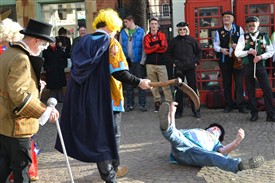
Muskham Pinkies Threshing blade kills the fool
RBParish
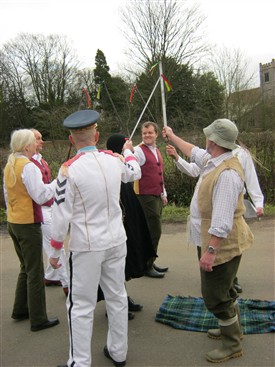
Sullivan's Sword Plough Play 2012 the sword dance dispatches Beelzebub
RBParish
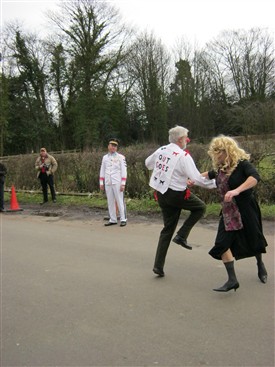
The Sullivan's Sword Plough Play 2012
RBParish
A January Custom
By R B Parish
Nottinghamshire should be justly proud of its role in reviving a colourful custom; the plough Monday play, a type of mummer’s or folk play. This was undertaken by plough workers commonly called Plough boys or bullocks.
January was of course an important time of year for the agricultural and ploughing resumed for the new year in January. However, across mainly the eastern counties of England, those associated with arable farming, took the first Monday after Twelfth night called Plough Monday, as quasi-official day off. Different activities were associated with the day: East Anglia, Cambridgeshire had its Molly Dancers and in some cases their strawbear (as resurrected in Whittlesea (revived 1980) and Ramsey (revived 2009) whereas Lincolnshire, Nottinghamshire, Rutland and Leicestershire had the Plough Bullockers and their play.
The basic plot
As stated these groups variously were called Plough or Bull Bullocks or Guysers (the later referring to the guiser or guyser deriving from dis-guise identifying the general blackening of their faces and fancy costume). Millington (2002) has recently reclassified the mummer’s play into Quack Doctor and within these sub groups Recruiting sergeant and Hero combat plays and in the county both types were encountered: a Recruiting Sergeant Quack doctor play was the most widespread mainly found in the eastern half of Nottinghamshire, but in a small region, north of Mansfield and south to Kimberley and along the Derbyshire border (but usually Christmas time), the Hero combat Quack Doctor was encountered.
The characters ranged widely but a group of core characters can be identified from each. The quack doctor-recruiting sergeant had the farmer, a devil character usually Beelzebub or Eezum Squeezum, a fool, ‘man-women’ Dame Jane and or Lady Bright and Gay and of course a quack/doctor and recruiting sergeant. The quack doctor hero-combat had similarly a man-woman character, a devil character, the doctor but St/King George and the Turkish Knight. In some cases a hobby horse present as recorded at Mansfield in 1870 and as noted below:
“ A party of mummers visited the towns & villages of North Notts during the past fortnight, and highly diverted the inhabitants by their dancing, singing of old songs, & the play of the Hobby Horse. The latter play was in existence in the days of the Plantagenets, & probably the song & tune which they sang, viz ‘When Joan’s ale was new.’”
What role the Hobby Horse had is unclear although of course a similar creature was present in the Owd Oss tradition .
The main plots, definitions from Millington (2002) are as follows:
The Quack Doctor Recruiting sergeant is the most complex and for more details the reader is recommended reading the works by Millington. Basically it involves the Recruiting Sergeant persuading the Farmer’s Man to desert his Lady Bright and Gay and enlist in the army. The Lady then takes up an offer of marriage from Tom Fool. Dame Jane enters with an illegitimate baby, which she tries to dump on Tom Fool. At this points Beelzebub, Eezum Squeezum or Threshing Blade, or some other character comes in and knocks Dame Jane, and then the Doctor is called in to perform comical diagnoses and cures.
In some cases other characters are introduced such as the Ribboner, Sanky although they do not add much to the narrative. It is tempting to think that the longer play was the original, but I feel it is probable that the play got extended as the ploughing community expanded and more people wanted to get involved. This can still be seen in the revivals such as the CRAPPPS Calverton play which in 2013 brought in or resurrected a new character bringing the group to a sizeable 11! This in itself made the play slightly more incomprehensible and consequently more esoteric due to its rambling nature and as Millington notes a parade of characters.
Quack Doctor Hero-combat has St./King George have a swordfight with an adversary, often called Slasher, his father or mother, a ‘man-woman’ calls for the Doctor is brought in to cure the loser. Sometimes a police man would be brought in.
Both plays ended in a song emphasising the need for money which would be collected often in the pan of Beelzebub.
The loss of the Plough?
Interestingly, although one may expect the plough itself to be prominent, many accounts make no mention of it suggesting towards the later end of its life as continuing custom it became rather cumbersome to carry and appears never to have been germane to the play. It is possible that the custom itself begun as a simple dragging of this plough. For example Shelford ploughmen and Waggoners drew a be-ribboned plough from door to door, cracking their whips and singing:
“My back is made of iron, my boots are made of steel, and if you don’t believe me, put out your hand and feel”
In many cases without sufficient recompense they would use this plough to plough up the gardens of those not donating money! The oldest references appear to be legal such as Sir John Markham of Rufford, prohibiting observances in the 1500s and most interesting a court case of North Muskham when some men were arraigned before the ecclesiastical court in 1596-97 for having ploughed up the church yard on “Plowe Daie” and abusing the vicar. They apparently appeared in court in costume, and the judge ordered them to turn back the furrows they had ploughed. Neither reference suggest plays, as claimed about the later by the present Muskham Pinkies, but does indicate the long history of the begging tradition at least. Such activities as the author states were probably a survival little more than in name, but such activities are still undertaken, albeit a revival in Hinckley Leicestershire on Plough Saturday.
It is possible that as the restrictions on using the plough declined and realising that their activities were more detrimental than helpful, the teams developed a play to gain a more substantial reward. This would be at odds with some views of the origins of the custom. In Nottingham it appears that the dragging of the plough ceased around 1870 as an account by the Old Timer (1925) notes:
“in some streets of Nottingham in the early 80s....went from yard to yard threatening to plough up doorsteps, although they had no plough...”
The origins
Much has been discussed of the origins of the plays. The commonest view indicated by a correspondent of Bagthorpe NWI:
Dressed in bizarre costumes and with blackened faces, local youths with a pretended show of force,....to re-enact the age-old story of the triumph of life over death in Nature, the origins of which go back beyond pre-Christian times. “
With a subtext of death and resurrection, this view is tempting some such as Brody (1969) and Ridden (1974) stressed an ancient and possibly pre-Christian origin of the play and the celebration. Needham (1936) drew a relationship between the geographical location, the north east and Dane Law. Others have highlighted the wooing aspect and drawn parallels with classical plays such as the 16th century Satyre of the Thrie Estasis.However, the simple fact that there is neither any record of plough plays before the 18th century nor any agreed pre-cursor plays has raised doubts to their ancient origins and no such plays exist in Denmark. Although it is possible that the plays hold some ancient message, it is equally probable that the plays arose in the 18th century if the 16th century reference from Muskham does not suggest a play. Indeed, the earliest account of such a mummers play is from nearby Reversby, Lincolnshire from 1779 by Morrice dancers and although undertaken at Christmas it is a plough Monday play. Certainly the plays have all the aspects beloved of the bawdy and raucous: the transvestite and their advances upon the young man, the boasting, the fighting, the fear of conscription and perils of a run in with an encounter with death or unwanted pregnancy..... Surely these components could equally arise at a student Rag event. Indeed, any place where young (often drunken) men want to shock and boast, such as the bragging plough boys. I feel that the begging tradition with the plough evolved in medieval times, and perhaps realising that simply begging and threatening did not work or that a performance earned more money the play begun.
The decline in Plough Plays
Through various sources it is possible to identify when at the possible last dates plough plays were last enacted; it would be rare in Nottingham by 1853, recorded in Bulwell in 1872, Wiverton 1893, Radcliffe on Trent, East Bridgeford, Bingham and Caunton 1900, Walesby 1904, Shelford 1912, Blidworth 1925 and the latest Tollerton in 1942. This decline in Plough plays would appear to be a response to changes in the agricultural economic landscape, as mechanism increased and labour demands dropped, the two fold effect of less plough boys to do the plays and a rise in the wages of those remaining made the background impetus, that of raising extra cash, less important. To this one may add the subsequent effect of two world wars and the demonization of begging, and the fate of plough plays was sealed. Like Poor Owd Oss and Derby Tup the tradition in some places fell to the children, with boy scouts recorded as doing it at East Markham and Hero-combat play being done in Selston-Brinsley area at least as late as the 1970s .Certainly this is the case in South Nottinghamshire where up until the Second World War it appears children would go house to house asking for the owners to ‘Remember the Ploughboys’ and as such the custom was a form of begging. A correspondent in the Nottinghamshire Guardian relates in Carlton:
“Whether any trace of the custom yet survives within the city borders I am not for the moment aware but it was not dead in the Carlton road district a quarter of a century ago, I can personally testify. It was then however a survival in little more than name, its observance being confined to boys of school age, and the dramatic element being wholly absent. It was called Plough Bullockin'....and of course transpired in the evening. Bands of boy, the number immaterial, would black their faces and equip themselves with old tin pans and anything calculated to create a dim and with the impromptu instruments in full operation, would solicit contributions at shop owners. This they probably did as meant for their own amusement as for any expectations of gain. At least I do not remember the clamour being universally received and peremptorily dismissed through the boys may have been in some cases bribed to pass on. No doubt they also find it essential to keep a sharp look police who would be unlikely to favour the sentimental aspect of the business”
From the late Mrs Richardson, brought up at Carlton, Headmistress of neighbouring Camblesforth school notes in NWI .
“In earlier times they danced in peoples gardens. You would have had to let them pull the plough through the house near Plough Sunday.”
Clearly the complexity of the plot of the play was perhaps too much for these informal groups of children to remember, unlike Poor Owd Oss and Derby Tup the plays lacked the memorable framework of a song throughout. Even the more memorable Hero combat play at Selston-Brinsley had a much reduced script. This would explain the clear debasement of the custom to the bear basics of a few lines, begging, rough music and the threat of ploughing. This certainly as the extract above suggests precipitated its demise, as they boys were seen more as threatening than continuing a rustic tradition. However, even the adult Plough boys did not themselves help preserve the custom in this respect. As early as the 1500s, Sir John Markham of Rufford, in the reign of Henry VII prohibited the observances of Plough Monday and of course there is the account from North Muskham as above. This later account suggested the main concern being the damage caused by the plough, however as the plough appeared to disappear, as a Mrs Brooks notes in 1952 at Caunton:
“teams of plough boys would burst into the house, and if they would not wanted it was wise precaution to bring in all the pails, mops and brooms as these would be taken.”
Sometimes the threats were more direct. Those at Lenton Sands “Kissed nursemaids and made babies cry” but in 1892 the situation went further at Wollaton, when the mummers frightened two horses which ran away and killed two persons. They were then banned from the top of Derby Road. Such high jinks became less acceptable as attitudes changed. Certainly at the reason for their final decline may be indicated at Underwood with Bagthorpe as the NWI notes:
“Mummer's plays were a feature of life in the area until the Second World War. Unfortunately, to safeguard the blackout in the war years, the police had to insist that the Mummers should play no more and another age-old custom was lost.”
The modern revivals
The rebirth of the Plough play can be seen to be solely an act in preserving the heritage of the custom for its own sake. In many cases, the rebirth of the Morris dancer has been pivotal in this, in others like minded preservationists, keen to see all traditions upheld have had a role and in some cases possibly a neo-pagan aspect has been involved keen to emphasize the death and resurrection aspects (certainly this appears the view of the Mushkam Pinkies who stated once it is a celebration of Mother earth). Often these attitudes are found in both camps. Presently there are seven revived performances: Calverton Plough Play (since 1978). The Foresters (1980s? Possibly before), Tollerton Plough Play (2002), The Dolphin Plough Play (2009) and Rattlejag Morris and Sullivan Sword Plough Play (since 2003?), Mushkam Pinkies (since 2000) and Clayworth Plough Plays (1982). The oldest revived play being that done by either the Foresters (they certainly were the first to revive it in the 1960s) or at Calverton by the Calverton Real Ale and Plough Play Preservation Society (CRAPPPS) are amalgamations of scraps of the local such as the Cropwell version and other plays such as Staunton, Lincolnshire, with natural evolution and asides over time. Most of these performances are done by Morris teams (Dolphin, Bleasby and Forresters), whereas that of both Calverton, Muskham Pinkies and Tollerton are plough only groups or local theatre groups. Tollerton, revived after a break of 50 years, is firmly a community based project fully supported by that community. It is perhaps the closest in tradition to the original, visiting local houses and enacted by local people for their community (some of whom may have had farming connections). Collections when made are done for charities rather than for the performers and interestingly none of these recently at least are agricultural or rural based.
Each of the plays is subtly different as well. Tollerton is lucky in having preserved an original script, in itself the basis of the Forester’s rendition combined with some Lincolnshire plays (related to the side by the original performers). Both it and Calverton’s are the longer quack doctor recruiting sergeant play with the two man-women characters. The Tollerton rendition contains a considerable amount of local jokes and the Foresters, done at Nottingham castle, makes more sense of the recruiting scene with some amusing regimental barracking. That done by Sullivan’s sword, the Farnsfield Play, unsurprisingly has a sword dance and Dolphin’s more recent rendition cleverly uses the basic formula and some of the traditional lines to give a more modern pantominesque performance, with more up to date puns, modern wear and the addition of the ‘No Win, No Fee’ character who enters with:
“In comes I no win no fee, An accident for you is commission for me, So if you’ve ever tried on a slab or bumped your head, Hit with a hand bag and fallen down dead, It doesn’t matter if anyone is to blame, I’ll make more profit than you if I handle your claim! Now the policemen’s gone back to the station, Sign this form for compensation”
That done by the Muskham Pinkies lack the illegitimate child scene and the ‘death’ caused by Threshing blade and the devil is Eezum Squeezum. It is based on that given to them by a Mr. Bill Gascoyne of North Mushkam in 1957. It also worth noting, the Ripley Morris’s rendition of the Hero-combat play in the Selston area however although this is a long lived revival, since 1983, it is enacted before Christmas and not Plough Monday.
All in all with their odd characters and sometimes confusing plot, the plough despite being divorced of its original usage still has the power to entertain and makes the Plough Monday play one of the county’s most vibrant folk customs...long may it continue, so remember:
“We are the country plough lads, That go from door to door, Good Master and Good Mistress, As you sit by your fire, Remember us good plough lads, That work through mud and mire, So bring us out a good pork pie, And a jug of your best beer, We wish you all good night And another Happy Year”
Extracted in part and extended from forthcoming book Nottinghamshire calendar: traditional ceremonies and customs of the county
References:
Anon.(1871) Mummers (Hobby Horse play, etc., in North Notts.)
Newark Advertiser , 18th Jan.1871
Anonymous (2010) Pinkies keep ancient play alive, Newark Advertiser Friday 22nd January 2010
E. B. (1929) Local notes and queries Plough Bullocks prohibited Nottinghamshire Guardian 26th January 1929
J. P. B (1893)Local notes and queries: English folk drama. Nottinghamshire Guardian 22nd July
Barley, M. W., (1953) Plough Plays in the East Midlands Journal of the English Folk and Dance society Vol 7 No 2 pp.68-95
Brody, A., (1969) The English Mummers and their plays: Traces of ancient mystery. London Routledge and Kegan Paul
Fisher, J. R. (1960) Memories of a villager Nottinghamshire Archives collection 12th March 1960.
Hutton, R., (1996) The Stations of the Sun. Oxford
Millington (2005) ‘Plough Bullocks' and other Plough Monday Customs in the Nottingham Area, 1800-1920’ Transactions of the Thoroton Society of Nottinghamshire, 2005, Vol.109, pp.127-137
Millington, P., & Jones, I., (2000-2005) Bibliography of Nottinghamshire Folk Plays & Related Customs. www.folkplay.info/Notts.htm , Accessed 22nd December 2013
Needham, J., (1936) The Geographical distribution of English ceremonial dance traditions Journal of the English Folk and Dance society Vol 3 No 1 pp.1-45
Preston, M. J., and Smith, P., (1999) A petygee of the Plough boys or modes dance songs. Sheffield National Centre for English Cultural tradition.
Ridden, G. M., (1974) The Goathland Plough Monday CustomsFolk Song Journal Vol 2 No 5 pp.335-388
F.M.E.W (1923) Plough Bullocks at Bulwell Nottinghamshire Guardian 26th January.
Collections:
Mrs Atkins and L. Butler (1952) Shelford Plough bullock play M.W. Barley Collection collected Dec 1952
Harry Clark (1971) Blidworth Plough Monday play P.T. Millington collection collected 28th May 1971